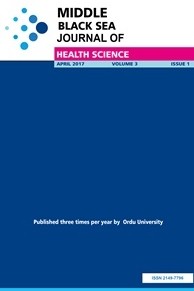Retrospective Evaluation of the Treatment of Wharton’s Duct Stones with Transoral Approach
Objective: Sialolith is one of the most common causes of salivary gland obstruction and often leads to sialadenitis. It usually seen in the submandibular gland around 80-90 percent. In this retrospective study, we aimed to retrospectively evaluate the treatment of sialoliths in different parts of the Wharton duct with transoral approach using minimally invasive techniques. Methods: After the clinical and radiological examination of eight patients, six male and two female patients, transoral removal of sialoliths detected in Wharton duct was decided. All surgical interventions were performed with a transoral approach using minimally invasive surgical techniques. Six patients were treated under general anesthesia and two patients were treated under local anesthesia. Results: 8 patients aged between 29-81 years who were transoral surgically removed Wharton duct stones. During the 20-month follow-up period, no intraoperative or post-operative complications such as bleeding and lingual nerve injury were observed. According to the results of the survey, 75% of the patients were very satisfied, 12.5% were satisfied and 12.5% were dissatisfied with the result. Conclusion: The transoral approach may be considered as a more effective option for the treatment of Wharton duct sialoliths because of the high success rate and the wider use indication compared to non-invasive procedures such as ESWL and sialendoscopy.
Keywords:
Wharton duct sialolith, transoral,
___
- Berini-Aytes L, Gay-Escoda C. Morbidity associated with removal of the submandibular gland. Journal of cranio-maxillo-facial surgery. 1992;20(5):216-219.
- Blatt IM. Chronic and recurrent inflammations about the salivary glands with special reference to children. A report of 25 cases. The Laryngoscope. 1966;76(5):917-933.
- Chossegros C, Guyot L, Richard O, Barki G, Marchal F. A technical improvement in sialendoscopy to enter the salivary ducts. The Laryngoscope. 2006;116(5):842-844.
- Combes J, Karavidas K, McGurk M. Intraoral removal of proximal submandibular stones–an alternative to sialadenectomy? International journal of oral and maxillofacial surgery. 2009;38(8):813-816.
- Escudier M, Brown J, Drage N, McGurk M. Extracorporeal shockwave lithotripsy in the management of salivary calculi. British Journal of Surgery. 2003;90(4):482-485.
- Eun YG, Chung DH, Kwon KH. Advantages of intraoral removal over submandibular gland resection for proximal submandibular stones: a prospective randomized study. The Laryngoscope. 2010;120(11):2189-2192.
- Foletti JM, Graillon N, Avignon S, Guyot L, Chossegros C. Salivary calculi removal by minimally invasive techniques: a decision tree based on the diameter of the calculi and their position in the excretory duct. Journal of Oral and Maxillofacial Surgery. 2018;76(1):112-118.
- Fonseca R. Oral and Maxillofacial Surgery, Vol. 5, Surgical Pathology, Saunders;2000.
- Gerni M, Foletti J, Collet C, Chossegros C. Evaluation of the prevalence of residual sialolith fragments after transoral approach of Wharton’s duct. Journal of Cranio-Maxillofacial Surgery. 2017;45(2):167-170.
- Goodstein L, Galinat L, Curry J, Luginbuhl A, Cognetti D. Sialendoscopy for Sublingual Gland Sialolithiasis: A Novel Technique. Annals of Otology, Rhinology & Laryngology. 2017;126(3):216-218.
- Hald J, Andreassen UK. Submandibular gland excision: short-and long-term complications. ORL. 1994;56(2):87-91.
- Hong KH, Kim YK. Intraoral removal of the submandibular gland: a new surgical approach. Otolaryngology—Head and Neck Surgery. 2000;122(6):798-802.
- Im Y-G, Kook M-S, Kim B-G, Kim JH, Park JY, Song HJ. Characterization of a submandibular gland sialolith: micromorphology, crystalline structure, and chemical compositions. Oral surgery, oral medicine, oral pathology and oral radiology. 2017;124(1):13-20.
- Kraaij S, Karagozoglu K, Forouzanfar T, Veerman E, Brand H. Salivary stones: symptoms, aetiology, biochemical composition and treatment. Br Dent J. 2014;217(11):23.
- Lafont J, Graillon N, Saïd MH, Tardivo D, Foletti JM, Chossegros C. Extracorporeal lithotripsy of salivary gland stone: A 55 patients study. J Stomatol Oral Maxillofac Surg. 2018 Nov;119(5):375-378
- Liao L, Hsiao J, Hsu W, Wang C. Sublingual gland sialolithiasis: a case report. Kaohsiung J Med Sci.. 2007;23(11):590-3
- Lustmann J, Regev E, Melamed Y. Sialolithiasis: a survey on 245 patients and a review of the literature. International journal of oral and maxillofacial surgery. 1990;19(3):135-138.
- Marchal F, Dulguerov P. Sialolithiasis management: the state of the art. Archives of Otolaryngology–Head & Neck Surgery. 2003;129(9):951-956.
- Matsunobu T, Kurioka T, Miyagawa Y, Araki K , Tamura A, Niwa K, et al. Minimally invasive surgery of sialolithiasis using sialendoscopy. Auris Nasus Larynx. 2014;41(6):528-531.
- McGurk M, Escudier M, Brown J. Modern management of salivary calculi. British Journal of Surgery. 2005;92(1):107-112.
- Nahlieli O, Nakar LH, Nazarian Y, Turner MD. Sialoendoscopy: a new approach to salivary gland obstructive pathology. The Journal of the American Dental Association. 2006;137(10):1394-1400.
- Ottaviani F, Capaccio P, Campi M, Ottaviani A.. Extracorporeal electromagnetic shock‐wave lithotripsy for salivary gland stones. The Laryngoscope. 1996;106(6):761-764.
- Schwartz N, Hazkani I, Goshen S. Combined approach sialendoscopy for management of submandibular gland sialolithiasis. American journal of otolaryngology. 2015;36(5):632-635.
- Zenk J, Constantinidis J, Al-Kadah B, Iro H. Transoral removal of submandibular stones. Archives of Otolaryngology–Head & Neck Surgery. 2001;127(4):432-436.
- Yayın Aralığı: Yılda 4 Sayı
- Başlangıç: 2015
- Yayıncı: Ordu Üniversitesi
Sayıdaki Diğer Makaleler
Ali ASLAN, Abdullah ÇIRAKOĞLU, Yeliz KAŞKO ARICI
Ahmet ÇALIŞKAN, Rıza DURMAZ, Canan ATEŞ GÜRSOY, Nilay ILDIZ
Erdem DEĞİRMENCİ, Zafer ORHAN, Mehmet ARICAN, Zekeriya KARADUMAN, Yalçın TURHAN, Ozan TURHAL
Ali YILMAZ, Hilal ALTAŞ, Timur YILDIRIM, Şükran KAYGISIZ, Hasan Serdar IŞIK
Kutsi TUNCER, Mehmet KÖSE, Murat TOPAL, Eyüp ŞENOCAK, Ömer Selim YILDIRIM
Bora ÇOŞKUN, Burcu TİMUR, Buğra ÇOŞKUN, Ferdi KINCI, Coşkun ŞİMŞİR
